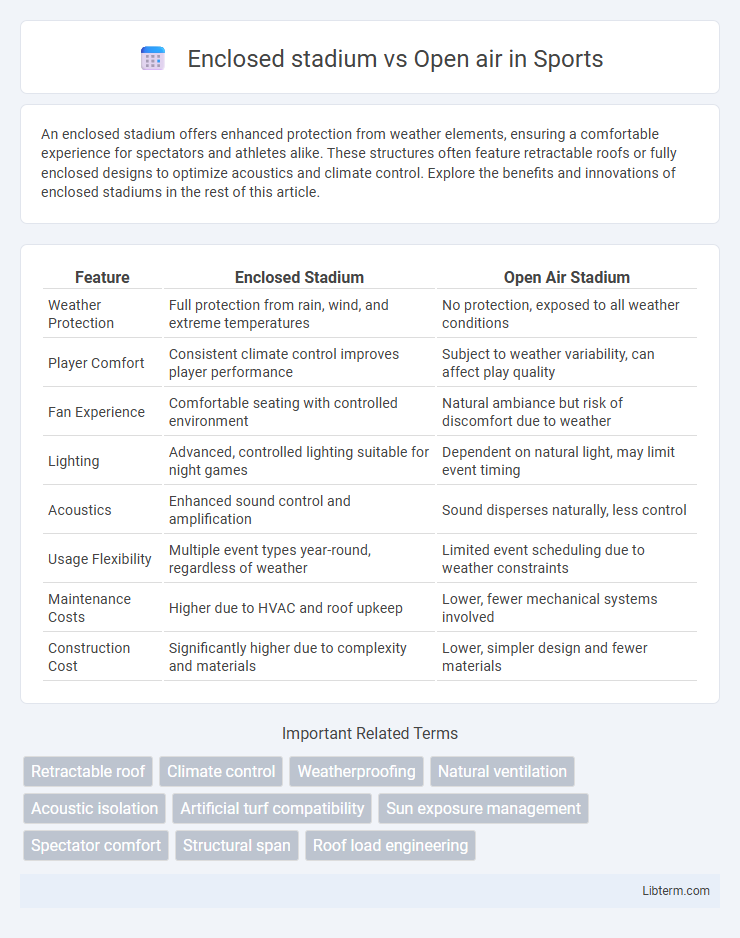An enclosed stadium offers enhanced protection from weather elements, ensuring a comfortable experience for spectators and athletes alike. These structures often feature retractable roofs or fully enclosed designs to optimize acoustics and climate control. Explore the benefits and innovations of enclosed stadiums in the rest of this article.
Table of Comparison
| Feature | Enclosed Stadium | Open Air Stadium |
|---|---|---|
| Weather Protection | Full protection from rain, wind, and extreme temperatures | No protection, exposed to all weather conditions |
| Player Comfort | Consistent climate control improves player performance | Subject to weather variability, can affect play quality |
| Fan Experience | Comfortable seating with controlled environment | Natural ambiance but risk of discomfort due to weather |
| Lighting | Advanced, controlled lighting suitable for night games | Dependent on natural light, may limit event timing |
| Acoustics | Enhanced sound control and amplification | Sound disperses naturally, less control |
| Usage Flexibility | Multiple event types year-round, regardless of weather | Limited event scheduling due to weather constraints |
| Maintenance Costs | Higher due to HVAC and roof upkeep | Lower, fewer mechanical systems involved |
| Construction Cost | Significantly higher due to complexity and materials | Lower, simpler design and fewer materials |
Introduction to Enclosed vs Open Air Stadiums
Enclosed stadiums feature fully covered structures that provide climate control and protection from weather elements, enhancing spectator comfort and allowing year-round use. Open air stadiums lack a roof, exposing events to natural weather conditions and often benefiting from natural ventilation and sunlight. The design differences impact factors such as acoustics, maintenance costs, and event scheduling flexibility in both types of stadiums.
Architectural Differences and Design Features
Enclosed stadiums feature a complete roof structure, utilizing advanced materials like ETFE or retractable panels to provide weather protection and climate control, while open-air stadiums prioritize unobstructed airflow and natural lighting with open or partial roof designs. Enclosed venues incorporate sophisticated HVAC systems and sound insulation to enhance spectator comfort, contrasting with open-air designs that emphasize natural ventilation and exposure to ambient conditions. Structural engineering in enclosed stadiums requires load-bearing frameworks capable of supporting roofing systems, whereas open-air stadiums focus on maximizing sightlines and integrating surrounding landscapes.
Climate Control and Weather Considerations
Enclosed stadiums offer superior climate control by maintaining consistent temperature and humidity levels, ensuring optimal comfort for athletes and spectators regardless of external weather conditions. Open air stadiums rely heavily on natural weather, exposing events to elements such as rain, wind, and extreme temperatures that can impact athlete performance and spectator experience. The choice between enclosed and open air venues significantly affects event scheduling, maintenance costs, and overall operation efficiency due to varying weather-related considerations.
Fan Experience: Comfort and Engagement
Enclosed stadiums provide fans with climate-controlled comfort, protecting them from extreme weather conditions and enhancing overall enjoyment. The acoustics in enclosed venues amplify crowd noise, creating a more intense and engaging atmosphere. Open-air stadiums offer a natural environment and scenic views, but fans may face discomfort due to weather variability, impacting their level of engagement.
Acoustic Performance and Atmosphere
Enclosed stadiums offer superior acoustic performance by containing and amplifying sound, creating a more immersive and intense atmosphere for spectators. Open-air stadiums often experience sound dispersion due to natural elements, resulting in less consistent audio quality but providing a dynamic ambiance influenced by weather and natural surroundings. The choice between enclosed and open-air stadiums significantly impacts crowd noise levels, clarity of announcements, and overall energy during events.
Energy Efficiency and Environmental Impact
Enclosed stadiums demonstrate superior energy efficiency through advanced climate control systems that reduce heating and cooling demands compared to open-air stadiums, which rely heavily on ambient weather conditions. The environmental impact of enclosed stadiums is mitigated by features such as solar panels, LED lighting, and energy-efficient HVAC systems, whereas open-air venues often require more extensive lighting and temporary weather-related infrastructure. Furthermore, enclosed stadiums can better manage waste and water recycling systems, contributing to lower overall environmental footprints than their open-air counterparts.
Cost: Construction and Maintenance
Enclosed stadiums typically incur higher construction costs due to the need for complex roofing structures, climate control systems, and advanced ventilation compared to open-air stadiums. Maintenance expenses are also elevated in enclosed venues because of the ongoing upkeep of mechanical systems, higher energy consumption for lighting and HVAC, and more frequent repairs to roofing and interior surfaces. Open-air stadiums benefit from lower initial investment and reduced operational costs but face challenges such as weather-related damages and more frequent upkeep of outdoor facilities.
Versatility for Events and Usage
Enclosed stadiums offer controlled environments ideal for diverse events, including concerts, sports, and conferences, due to protection from weather elements and advanced climate control systems. Open-air stadiums provide natural ambiance and accommodate large-scale outdoor events like festivals and athletics, but their usage can be limited by weather conditions and seasonal changes. Versatility in enclosed stadiums extends to year-round scheduling and adaptable setups, whereas open-air venues often require contingency planning to ensure event continuity.
Safety and Security Factors
Enclosed stadiums offer enhanced safety and security through controlled access points, efficient surveillance systems, and protection from external weather hazards, reducing risks of crowd-related incidents and unauthorized entries. Open-air stadiums, while providing natural ventilation and easier evacuation routes, face challenges in perimeter security and exposure to environmental threats like extreme weather or airborne objects. Implementing advanced security technologies and trained personnel is essential in both settings to mitigate risks and ensure visitor safety.
Future Trends in Stadium Architecture
Enclosed stadiums are increasingly incorporating advanced climate control systems and retractable roofs to enhance spectator comfort and event versatility, reflecting a growing trend in sustainable design and user experience. Open-air stadiums prioritize integration with natural surroundings and employ innovative shading technologies and eco-friendly materials to reduce environmental impact while maintaining atmosphere. Future stadium architecture emphasizes adaptability, energy efficiency, and immersive fan engagement, blending digital infrastructure with architectural innovation regardless of enclosure type.
Enclosed stadium Infographic

 libterm.com
libterm.com